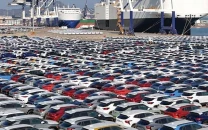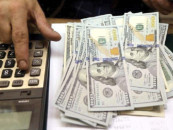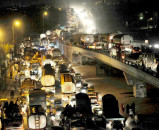Trump's policy shift flips US economy
The once-mighty US stands on the edge of self-inflicted turmoil, needs a new approach

America the "Land of Opportunity" has become the "Land of Paradise Lost" as prosperity has been turned into poverty and industrial productivity has also has emerged as a driver of economic recession, causing high inflation, price hike, and shortage of basic necessities of life in major stores, leaving ordinary people feeling the impact of President Donald Trump's tariffs.
It is imminent that the US government, through quiet diplomacy, consultations, and negotiations, will approach Chinese authorities to stabilise its economy, sustain growth, streamline global supply chains, and smooth industrial production very soon.
According to CNN, the decline from China will be even starker. JP Morgan expects a 75% to 80% drop in imports from there. When it comes to shipping and ports, even so, sailings from China to the US fell 60% in April, according to Flexport, a logistics and freight forwarding broker. Once the cargo hits US ports, the goods take as little as a few weeks to hit store shelves. And when the current inventory runs out, more expensive tariffed items will make their way onto shelves. Americans rely on China for thousands of products, everything from flat screen TVs to baby strollers. US businesses import more toys, apparel and footwear from China than any other country, according the United States International Trade Commission.
The Economist has reported that the world is now desperate to assess the damage caused by Donald Trump's swingeing tariffs on Chinese imports, and pundits are again using innovative techniques. Their findings suggest the world's biggest economy is not reeling yetbut trouble is creeping in. Even before the implementation of many tariffs on April 9, polling suggested American consumers and businesses were worried. According to a survey by the Dallas branch of the Federal Reserve, manufacturers' output fell to a record low in April. And figures released on April 30 showed that America's GDP contracted by 0.3% in annualised terms. The trade deficit swelled as companies rushed to build up inventories of foreign goods before the tariffs came into effect.
Centre for South Asia and International Studies Islamabad Executive Director Dr Mehmoodul Hassan Khan said, "From Adam Smith's classic book Wealth of Nations to Abhijit Banerjee and Esther Duflo's Poor Economics and Abhijit's Good Economics for Hard Times, all clearly uphold that the continuity and deepening of structural reforms are essential for economic stability and sustainability. Policy abruption only achieves ashes, shamans, smoking mirrors producing policy disconfirm, economic uncertainty and societal disarray and it is happening in the USA, the "Land of Dreams" which has now become "Land of Decry."
Evidently, the economic reversal has become a bitter reality, leaving the US population as 'wondering souls.' The US government urgently needs straightforward economic engineering, people-focused marketing strategies, social entrepreneurship, the revival of Small and Medium-sized Enterprises (SMEs), community development experts, and an innovative, knowledge-based economy. These elements will propel its economy, society, and industries towards greater sustainability and diversity, reducing the trade surplus in the US's favour, rather than pursuing excessive tariffs.
International trade expert Dr Aadil Nakhoda said "We are already seeing a fall in the economic indicators in the US. So, the confidence is low as such measures have hampered the business sector. As the US may have difficulty in procuring substitutes locally and from other sources, the economy will move in reverse till the supply chains are restored.
As the US-China trade reduces, "we can anticipate that other countries will take proactive steps and make arrangements to form a low tariff corridor, create multilateral agreements to absorb the shocks, ensure that collaboration in productive capacities creates better synergies across smaller countries and potentially use the sum of their trading power to negotiate diplomatically for concessions," he added.
First, it is important to note that although imports to GDP is only 16% in the US, the US is mainly a service-oriented economy with demand for manufactured goods being catered through imports. Therefore, shortages will hit the supply chains, especially of low valued goods purchased from China. Right now this trade war is limited to China as other countries have been given a pause. There will be settlement soon once both sides have exhausted their power to resist.
JP Morgan, Wall Street, The Economists, International Monetary Fund (IMF), World Bank (WB) and many independent economists are divided to predict the future of the US economy however, one thing is crystal clear that recession, inflation, acute price hike, shortage of routine items, and declining consumer spending are hurting the US economy and political outlook.
The dissenting tone of more than 12 states especially California (the larger than the economy of Germany) defiance of some local industries (IT, mobiles, computers, and digitalization), division in the cabinet and fading charisma of Trump as Chief Deal Maker has not yet conquered Xi's statesmanship, visionary economic policies, befitting global socio-politico plans and public goods have become living realities.
Thus emerging trends are pushing towards fatal fears compelling faulty lines in the US economy standing far away in terms of GDP, industrial development, digitalization, AI, green technologies and robotic modernization as compared to China which has become the real champion of digitalization, modernization, AI, and all emerging futuristic fusions.
It fears that idle ships and empty ports will be the future of shipping companies having no orders for international trade. Despite the US President Donald Trump, China will remain America's most important trading partner.
However, because of the ongoing staggering tariffs and trade war there will be shortage of clothes, footwear, electronics and microchips, which power appliances, thermostats and anything else that beeps.
Additionally, some products will be hard to find or may be too expensive to buy in the future. National Retail Federation (May 2025) estimates that imports into the United States during the second half of 2025 are expected to fall at least 20% year over year, painting a weak economic prospects of the US economy.
It is predicted that international trade will be the easiest prey of ongoing US trade and tariffs. The World Trade Organisation (WTO) role, status, authority and conflict resolution ability will be further marginalized because of King Trump self-centric policies which have now been dubbed some jerk policies which do not have justifications.
Dr Khan said the US-China trade war will significantly squeeze international trade and the global economy, primarily through increased tariffs and trade uncertainty. This has led to decreased trade volumes between the two countries, disruptions in global supply chains, and overall economic instability.
Reduction in trade volumes, disruption in supply chain, trade diversion, rise to global south, predominating role of the BRICS, Shangai Cooperation Organisation (SCO), Association of Southeast Asian Nations (ASEAN) and Belt Road Initiative (BRI) would be bitter realities.
THE WRITER IS A STAFF CORRESPONDENT




















COMMENTS (1)
Comments are moderated and generally will be posted if they are on-topic and not abusive.
For more information, please see our Comments FAQ